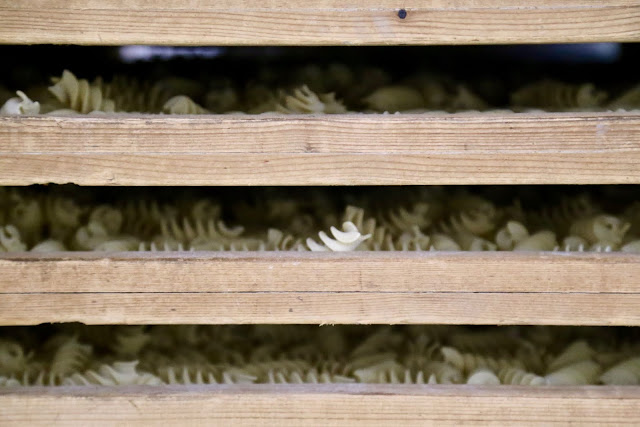
Gragnano, pasta town, Italy
Have a good look at packs of pasta next time you go food shopping. You’ll see that many of the best brands are made in Gragnano, a hilltop town south of Naples.
Last year I visited Gragnano, specifically the factory Pastificio Dei Campi, which, according to Italian food experts that I know, is reputed to be the best pasta in Gragnano.
It comes in a glamorous gift packaging, looking more like a high end perfume or beauty product. Housed in a thick red, black, white and gold satin cardboard box, with a cellophane window to see the contents, bound with a wax sealed ribbon, you slide out the inner box, containing the most elegant bronze die pasta. A bronze die is a metal mould with rough sides, which creates a rough sandy surface on the outside of the pasta, meaning any sauce will cling.
Guiseppe Di Martino has been making pasta for three generations, owning three different dry pasta factories and three for fresh. Pastificio Dei Campi is their top end brand, established in 2007, to preserve the traditional artisanal way of producing pasta. There are different pressures, temperatures, different ways of drying pasta.
Pasta Q and A
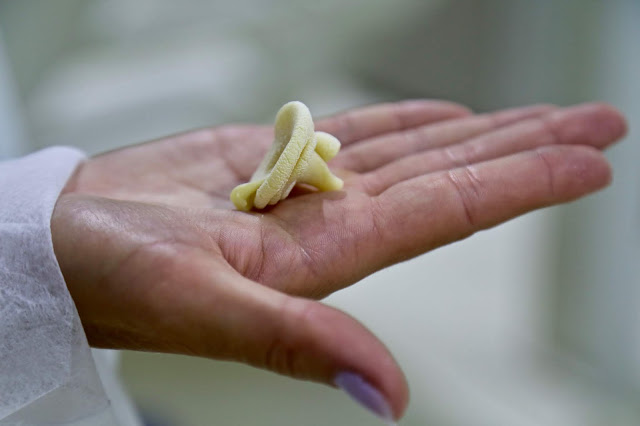
What is your most popular shape?
It depends on the country. Usually spaghetti.
In Italy?
Spaghetti. Here there is a trend towards bigger forms like Spaghetti Maxi, a bigger type of spaghetti.
How long does Spaghetti Maxi take to cook?
13 minutes as opposed to the classic 8 minutes.
We have four different types of pasta: spaghetti, vermicelli, spaghettini, spaghetti Maxi
In the UK is spaghetti the most important shape?
Yes spaghetti, also linguine, plus short shaped pasta like penne rigate and oriechiette.
In the USA?
In America they like grooved pasta shapes. Industrial pasta is usually all smooth. But industrial producers like Barilla decided to introduce a grooved pasta because it was faster to produce, but they did it not with bronze dies but with teflon.
It imitates bronze die?
It tries, but if you use good quality pasta, you don’t need grooves.
Is Barilla the most popular brand in Italy? In Italian supermarkets I’ve seen aisles and aisles of blue packaging of Barilla.
It’s very industrial. Barilla isn’t great quality, the best pasta is Gragnano pasta.
Why is Gragnano known for pasta?
They say that pasta was born here. It dates back 500 years. Here we have many generations of pasta producers. We only employ pasta makers who are sons, daughters, grandchildren of pasta makers.
They must have generational know how?
We employ only locals to actually make the pasta.
The climate here is perfect for the slow drying process. In ancient times, when machines didn’t exist, they made it all by hand and dried it outside. In the daytime, the sun dried it fast and in the night time, the humidity and the sea breezes gave the pasta the right texture. The pasta is better preserved, and the grain lasts longer.
We try to dry as slowly as possible, It takes 24 to 72 hours to dry our pasta. Just to compare, Di Martino, our other brand, dries in 6 hours. We need 24 hours for small shapes and 72 for long shapes
With long candele which you break by hand, you need 80 hours drying time and 15 days of stabilisation. We need to check the drying process went well.
Bronze die, are they made of bronze?
Yes. Bronze metal is very important in pasta production, it gives a rough surface.
We go inside the factory, it’s very very clean, but also hot and noisy.
We have no kind of air conditioning unfortunately, which is awful for the workers but good for the pasta. The pasta is very sensitive to the outside temperature.
Where do you get the flour from?
We have only one supplier, in Puglia. They cultivate the grain, the hard durum wheat, organically for us. That’s why we are unique. We can track our grain. If you go to our website, there is a certificate and you can see on google maps where the grain was grown for every packet.
We have a three year rotation, cultivating our grain the ancient way. The first year our farmers grow legumes, the second year the soil lays fallow, and the third year we grow the grain. This way we obtain a high level of proteins within the grain without using pesticides.
The harvest is ready in mid June. Then it’s made into semolina. The farmers mill the grain to order and it takes 3 hours to drive from Puglia to Gragnano. So it’s very fresh.
Most grain for Italian pasta is imported from Canada. In order to withstand shipping which lasts a month, the grain becomes humid from being at sea. This compromises the quality.
Tour of the Pastificio Dei Campi factory
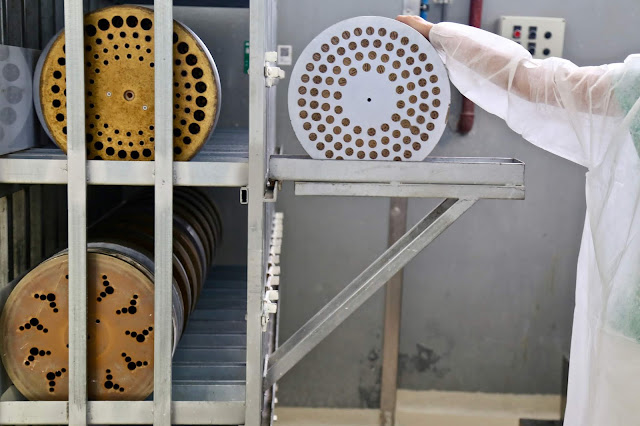
I am shown the bronze dies and pick one up:
They are very heavy I comment.
Each pasta shape has its own bronze die. For instance this is for ziti.
Here are bronze dies for short pastas.
Here is campotti, our exclusive pasta shape.
And traditional for Gragnano is the mixed pasta shape, to have all different shapes in the same box.
When Italy was a poor country, Italian families were big, so as not to throw the end of a box away, they mixed pasta shapes.
I’m quite shocked by this. I row with my daughter about this. I think it’s a bit sacrilegious to mix your shapes. They all have different cooking times for gods sake!
We have traditional recipes for mixed pasta shapes. The classic sauce is with potatoes and Provola:
You fry the potato cubes, then add onion, then water, and make a soup.
Then you put the pasta in the soup.
You must have the right amount of water so that the pasta absorbs the water and becomes like a normal pasta dish not a soup.
How do you clean them?
With a special machine, it’s important to make sure there is no leftover dough.
How many kilos of pasta do you use a year?
Per day, maximum capacity, is 3000 kilos.
We do 60 different shapes: 57 types are produced with bronze dies.
The other three, such as orecchiette are done in machines that imitate women’s hands.
We use only Gragnano water, which is very pure and is taken from the mountains.
It is mixed with semolina and pushed through the bronze die.
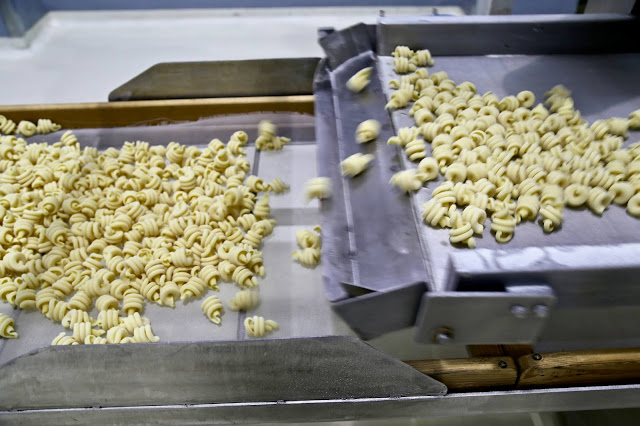
I gaze with fascination at the pasta machines which are currently making trottole, shaped like a spinning top.
I touch the pieces: they are warm and soft, you can shape it. I taste it.
You can taste the sweetness, feel the roughness.
It comes out the other end and is then put into wooden racks.
Then the racks are taken to cells.
It’s beautiful.
It’s very humid in the storage rooms for the pasta. Then they test them by cooking upstairs.
To find out the optimum cooking time? In the south of Italy they like it very al dente.
Our cooking time on the packet is al dente.
Good quality pasta takes more time to be cooked. If it’s eight minutes or more it’s fine. If it’s five minutes, don’t buy it. Quick cook is obviously a crime against pasta.

How to recognise good pasta

An artisanal pasta is pale and rough, and dusty looking. Because it’s dried slowly, it holds together better, it expands more, and it doesn’t break when you cook it. It has more resistant starch and is therefore healthier for say diabetics. If the grain is local, it is less likely to have damaging moulds (which is often what gluten sensitive people have problems with).
Industrial pasta is yellower, and almost plastic looking. There is no powder because the drying process is different. They dry the pasta at a higher temperature. If you work with it at a high temperature, it caramelises. There is no starch inside. It’s very breakable and you will see that there are little chips off the spaghetti strands. It’s brittle.
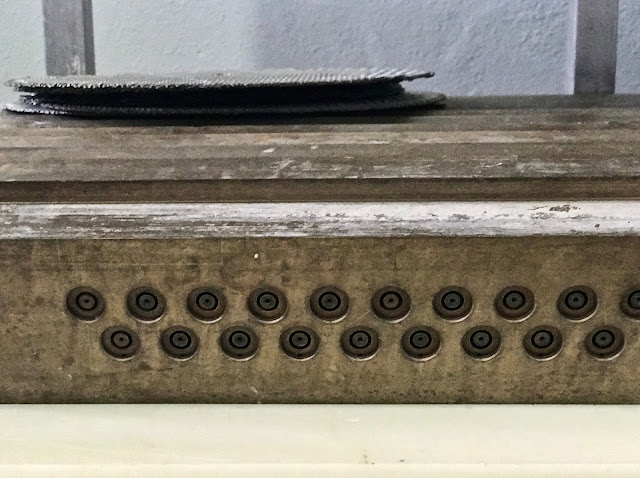
Stockists in the UK
Marks and Spencer
Andreas Veg in Chelsea
Taste Test
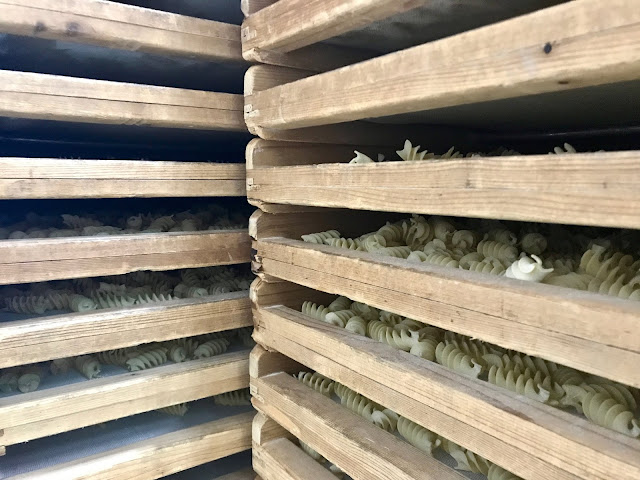

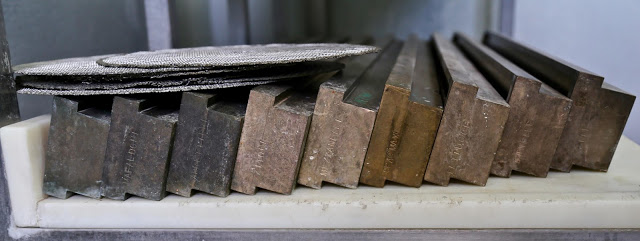



Update: I’m still collecting brands of spaghetti. I have like 40. This is still on the back burner.
Hello there,
I enjoyed your article. Thanks for sharing!
I will be traveling to the Naples area and wanted to ask how do I get a tour at the pasta factory?
Would you mind sharing? Do I have to make arrangements in advance?
Thanks for your input. I await your response. Best regards, N. Llorente
You have to go to Gragnano from Naples, which is about half an hour by car and two hours by public transport. I’m not sure if Di Martino do tours for the public.